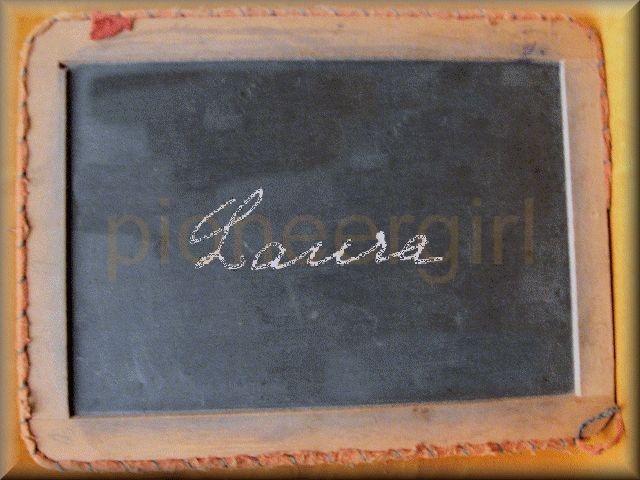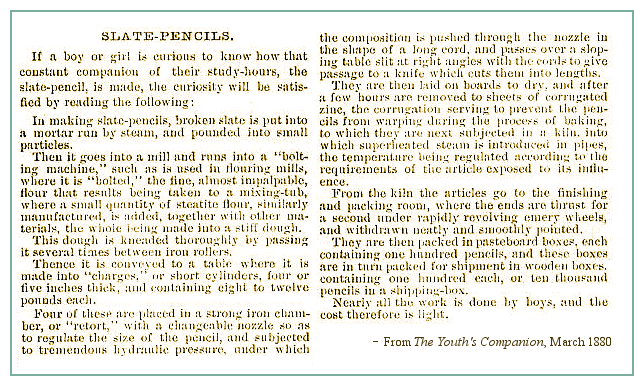slate

An argillaceous stone which readily splits into plates; argillite; argillaceous shist. A prepared piece of such stone; especially, (a) A thin, flat piece, for roofing or covering houses; (b) A tablet for writing upon. — Webster, 1882
 In On the Banks of Plum Creek (Chapter 21, “Nellie Oleson”), Laura and Mary buy their first, shared slate from Mr. Olseon’s store. Wilder doesn’t include the cost of the slate, but Pa counted his money and gave the girls a “round silver piece” with which to pay. Purchasing the slate isn’t mentioned in the existing manuscript for On the Banks of Plum Creek, where Laura and Mary each seem to have their own slate, nor in the handwritten Pioneer Girl manuscript, where the first mention of a slate is not until Miss Wilder’s class in De Smet.
In On the Banks of Plum Creek (Chapter 21, “Nellie Oleson”), Laura and Mary buy their first, shared slate from Mr. Olseon’s store. Wilder doesn’t include the cost of the slate, but Pa counted his money and gave the girls a “round silver piece” with which to pay. Purchasing the slate isn’t mentioned in the existing manuscript for On the Banks of Plum Creek, where Laura and Mary each seem to have their own slate, nor in the handwritten Pioneer Girl manuscript, where the first mention of a slate is not until Miss Wilder’s class in De Smet.
In the Laura Ingalls Wilder / Rose Wilder Lane Home & Museum in Mansfield, Missouri, there are two slates on display; they are identified as belonging to Mary and Laura. The slates are of different sizes, and one has red string lacing around its perimeter.
In June 1936, while reviewing the manuscript for On the Banks of Plum Creek, Rose Wilder Lane wrote a letter to her mother, in which she asked: “What was the slate and slate-pencil like? Just like the ones that I used to have? Red paper around the pencil, and red lacings (string) around the slate, holding the wooden frame on?”
To which Laura replied: “The slate had a brown, wood frame, mortised at the corners, made to fit, no lacings. Pencils were just the smooth round slate, no trimming.” So perhaps the slates in Mansfield belonged to Laura and Rose, or one was Mary’s from a later date.
It seems that lacing was more than mere decoration or “holding the frame in place” – it was often used to secure a narrow band of felt or leather around the slate frame. This would act as a silencer of sorts, to muffle the sound of a wooden slate against a wooden desk top. Another type of noiseless slate had felt between the slate and wooden frame to keep the stone itself from rattling.
If you have a slate with a plain, wooden frame, you can add lacings by drilling small holes evenly spaced around the perimeter, then sew: heavy red string, a long shoe-lace, or leather over-and-over around the frame, as seen in the early advertisements for slates, shown below. These 1890s prices would suggest that Laura’s and Mary’s 1874 slate would probably have cost about ten cents.

What is slate?
Slate is a fine-grained sedimentary rock formed when shale (clay or volcanic ash) is subjected to pressure and heat. It is deposited in layers; therefore, it can be split into thin sheets. Some modern writing “slates” aren’t made of slate at all. They are pressed wood painted black. A true slate will be the same on both front and back. It will be breakable, and it will show a mark when written on with a piece of slate.
Slate Pencils.
A slate pencil is a thin piece of slate, either plain, encased in wood like a lead pencil, or wrapped in paper. They can be sharpened to make a fine mark on the slate. Cheaper soapstone pencils are also used on slates. Both slate and soapstone pencils are very breakable.
The Slate Rag.
Marks on a slate could be rubbed out with the wrist or piece of cloth. Scholars could sprinkle their slate with water from a small bottle kept at the desk, or wipe with a damp cloth or sponge before using a rag to dry the slate prior to re-use.

slate (FB 27; BPC 20-21, 26, 31, 34, 36, 38; TLW 8-9, 15, 22; LTP 14-15, 22-25; THGY 10, 15, 27; PG)
Braille slate (LTP 19, 25; THGY 15; PG), see Braille
slate pencil (BPC 21; TLW 22; LTP 15, 17, 25) – A piece of slate, or of soapstone, resembling in form a lead-pencil, and used for writing on a slate.
slate-rag (LTP 15) – Any thing used to wipe a slate clean.
“special slate to write on” (LTP 19; PG), see also Braille – A grooved, metal slate which enables the writer to feel the lines, thereby writing in a straight line on paper placed over the slate.

